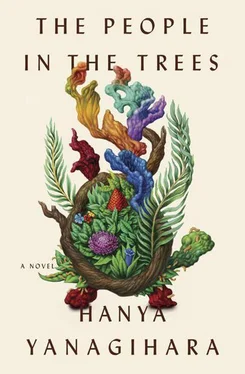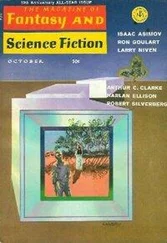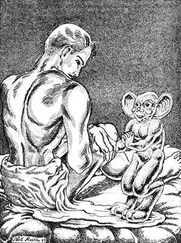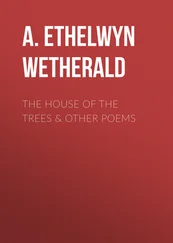The huts in the second ring — actually, it was more of a half-ring, a crescent that hugged the backs of half of the sleeping huts in a loose embrace — were of the same build and shape, but these, unlike those in the first ring, were used for storage. The first was the meathouse. After one of the women had left it, I walked in and saw that the entire floor had been hollowed out, maybe about ten feet down, and that its bottom was lined with parcels made from dark, glossy leaves. The villagers had carved from the dirt crude steps that led to the depths of the hole, and I climbed down them to scoop up one of the packets, which was cool and heavy with something dense but yielding. As I was lunging upward, however, my foot slipped and I caught myself against the leaves lining the floor’s bottom. As I did so, I felt the ground shift under me, a gentle sway, and when I reached my hand under the leaves to investigate, I felt a cold slosh of water and realized that they had dug down to an underground stream, which they were using to refrigerate the meat.
The next three huts held dried things, many of them tied to braids that crisscrossed the interior of the space like strands of Christmas lights. I identified a string of vuakas hanging by their poor, hairless tails, their eyeballs sunken and clouded, and another heavy with dried manamas, their once-babyish skins leathered into wrinkled hides, and a third of mangoes, their scent still richly sugary. There were other things too, things I could not identify: something that resembled a flattened lizard, with a hideous death grin of burned-toffee fangs; plump cigars of dusty, silvery leaf sacs that appeared hollow but whose weight sagged their line until it almost brushed the floor; translucent amber triangles speckled with sprouty black hairs. In the baskets that lined the walls I found more of those pinecones (unexpectedly weighty, and fuzzed like mushrooms), seedpods of various lengths and widths, and fungi of different shapes and mustardy shades, and one, woven very tight, abrim with handfuls and handfuls of what looked like toenail clippings but that I eventually realized were hunonos.
The fifth hut was the only one occupied, but the three women within it, after looking up and seeing me, quickly returned to their silent work. Two of them were braiding fresh green palm into ropes, and the third was shredding the long leaves into strips. A braid demanded three pieces, each about four inches in width. The center section was taken from the center of the leaf itself, the part with the spine; the other two pieces were taken from its softer and more pliable wings. The leaves were quite long, about eight feet or so, and when the women were finished braiding the length of one leaf, they would hasp it to another braid with a short rolled rope of a curly, noodley plant that resembled Spanish moss. All around them, in neat coils stacked on the floor and hanging from the inside of the cape, were lassos of this rope in various stages of drying and in various lengths and thicknesses. The two huts adjacent to this held more rope and more capes for the huts, and other things made of the palm rope as well: nooses (for the hogs, I imagined) with long leashes, braided trebly thick, and a shoulder-high stack of palm-frond mats, and long, sawed-off pieces of palm, one end sharpened into a point so it could be driven into the earth and a hut staked around it.
There was no one sitting in the next hut, but it too was clearly some sort of workshop, for there was an indentation in the center of the floor where someone might sit and a large stone, its surface worn flat, that was clearly used as a table. Stacked in pyramids to the left and right of this were more lengths of palm, slenderer than the ones I had found in the previous hut, some of which had been polished and sharpened, and I realized that this was a place for making spears. 36
I found myself admiring the village, even its simplicity. Yes, it was a crude sort of life, but there was a cozy sense of bounty here, of everything having its place, of every need of life — food, shelter, weaponry — being well considered and provided for, of life stripped to its essence and yet comfortably fulfilled. How many societies can say this, that they have recognized all they need and have made provisions for it all? Here there was food and a source of water and the tools of self-defense, all of it not only available but of a surplus. This, I thought approvingly, was a place that had no needs, and therefore no wants.
So I was perplexed by the final hut, the ninth. Unlike the other structures, this was draped with not one but two capes, and inside the floor too was covered with a cape. Atop this cape was a woven-palm mat, but unlike the sleeping mats I had seen, this was wider, as if it were meant to accommodate two people instead of one. The hut was unlike the others for another reason as well: this was the only one that had any sort of decoration. Here, lashed to the supporting beam, was what I recognized as an opa’ivu’eke carapace, so beautifully polished that each of its bony plates glinted as if faceted, even in the gray nonlight of the hut. It was a mystery, this hut, especially after the straightforward utilitarianism of the others, and I even peeled back the edge of the carpet to see if some explanation might be hidden beneath: a secret bunker, perhaps, or a subterranean storage space. But there was nothing, only the ground, and after I left the hut and walked away, I could feel its presence, as if it existed only to remind me that in my tidy theories about the simplicity of life here I might after all be mistaken.

It was only after I had finished exploring all the huts that I realized I was hungry, and once again I was drawn to the fire.
I should interrupt myself here and explain that one of the reasons it was impossible to see the village as anything but benign — despite the omnipresence of the hogs, and the spears, and the fact that I was an intruder — was that it was so small. It took me only some eighty strides to walk from one side of the village to the other, and aside from the hogs, everything within it seemed miniature in scale: the huts were short, the people were short, even the flames spitting up from that ever-burning fire were short.
I stood quite near the fire and waited for someone to offer me some food. All around me was industry: there was a cluster of five women tenderizing a large misshapen side of unidentifiable meat with stones, and another group of six sorting through a small mountain of manama fruits — the bruised and inanimate ones they sawed lengthwise into thin rounds; the ones that pulsed with hunonos they placed in a separate stack. The trio I had seen with the pineconelike vegetables had moved on to a pile of what looked like sausages, chubby little logs of young green, and I watched as they split them with a palm blade and flicked out the seeds within, which were kidney-shaped and the size of my thumb and a marbleized lilac and peach color. They talked among themselves, but not consistently, and only briefly: one would speak, and her companions would make a low, whistling grunt of agreement, so that it sounded in the moments between declarations as if a fug of wasps were hovering overhead.
To the right of the fire were the men, nineteen of them, including the village leader, who were using short, sturdy, sawtooth-edged leaves to polish and sharpen their spears. I stepped closer and saw that in the center of their circle were two bowls made of halved no’aka shells, each of which contained a little pudding of something jellied and the color of diluted milk. After they had addressed their spears’ tips, the men would reach two fingertips into the bowl and stroke some of the substance down their weapons’ shaft, repeating the gesture several times. Unlike the women, the men did maintain a steady sort of conversation, one that rolled and overlapped itself, an echoing monotone that sounded more like a chant than like speech.
Читать дальше













